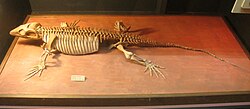Varanopid
| Varanopidae Temporal range: Late Carboniferous - Middle Permian, 300–260 Ma |
|
|---|---|
 |
|
| Fossil skeleton of Varanops brevirostris in the University of Michigan Museum of Natural History | |
| Scientific classification | |
| Kingdom: | Animalia |
| Phylum: | Chordata |
| Clade: | Synapsida |
| Clade: | Eupelycosauria |
| Family: |
†Varanopidae Romer and Price, 1940 |
| Genera | |
|
See below |
|
See below
Varanopidae is an extinct family of synapsid "pelycosaurs" that resembled monitor lizards and might have had the same lifestyle, hence their name. Like many other pelycosaur families, they evolved from an Archaeothyris-like synapsid in the Late Carboniferous; they had become extinct by the end of the Middle Permian. A varanopid from the latest Middle Permian Pristerognathus Assemblage Zone is the youngest known varanopid and the last member of the "pelycosaur" group of synapsids.
No known varanopids developed a sail like Dimetrodon. The length of known varanopids, including the tail, varies from 1 to 2 meters (3 ft 4 in to 6 ft 7 in). Varanopids already showed some advanced characteristics of true pelycosaurs such as their deep, narrow, elongated skulls. Their jaws were long and their teeth were sharp. However, they were still primitive by mammalian standards. They had long tails, lizard-like body, and thin legs. The varanopids were mostly carnivorous, but as they were reduced in size, their diets changed from a carnivorous to an insectivorous lifestyle. Compared to the other animals in Early Permian, varanopids were agile creatures.
Class Synapsida
Apsisaurus was formerly assigned as an "eosuchian" diapsid. In 2010, it was redescribed by Robert R. Reisz, Michel Laurin and David Marjanović; their phylogenetic analysis found it to be a basal varanopid synapsid. The cladogram below is modified after Reisz, Laurin and Marjanović, 2010.
...
Wikipedia
